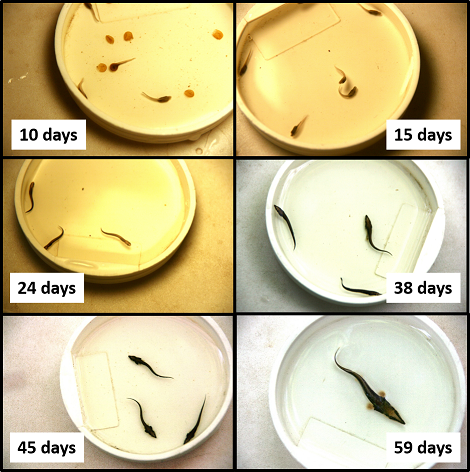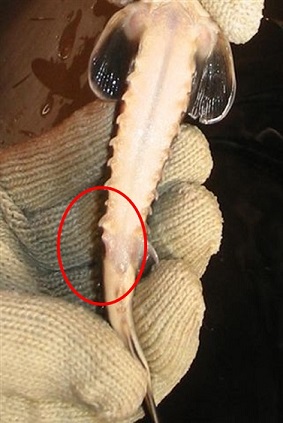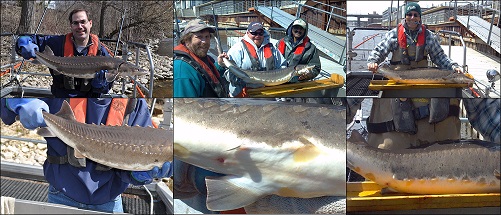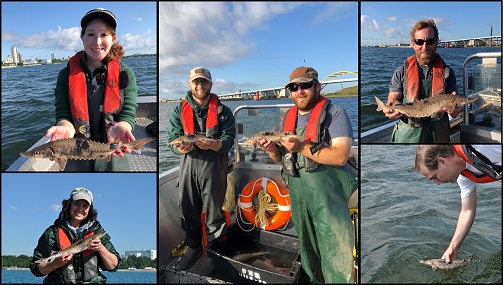Lake Michigan Lake Sturgeon Rehabilitation
Fishing Wisconsin
The Wisconsin Department of Natural Resources has developed a Lake Sturgeon Management Plan for the entire state. As part of this plan, certain Lake Michigan tributaries have been identified in the priority list of Wisconsin Lake Sturgeon Rehabilitation waters.
Historical Locations
The lake sturgeon occurs in the Mississippi, Lake Michigan, and Lake Superior drainage basins. In the Lake Michigan basin, it occurs in Green Bay, Lake Michigan, the Menominee River upstream to the White Rapids Dam, the Fox River upstream to Lake Puckaway, and the Wolf River upstream to Shawano. This system includes Lakes Winnebago, Butte des Morts, and Winneconne, and the Embarrass River. The lake sturgeon is listed as a rare species in the United States. Over most of its range in the United States, it appears to be threatened. In Wisconsin, it is common in the Menominee River, the lower Wolf River, Lakes Poygan and Winnebago, Lake Wisconsin, the St. Croix River to Gordon Dam, Namekagon River below Trego Dam, and the Chippewa and Flambeau rivers. It is uncommon to rare in the lower Wisconsin River, Mississippi River, the Madison lakes, and Lakes Michigan and Superior. The Wisconsin Department of Natural Resources has given the species "watch" status.
Because Wisconsin has given Lake Sturgeon a "watch" status, the Department is committed to the rehabilitation of Lake Sturgeon in extirpated areas. In 2002, the Department requested 2,000 fingerlings of Lake Sturgeon be produced for the Milwaukee River. We stocked these sturgeon in the fall of 2003 and continued this type of stocking until 2006. Starting in 2006, streamside rearing facilities have been used to produce Lake Sturgeon for stocking into the Milwaukee River. To gain knowledge on sturgeon habitat use, seasonal migration patterns and effects of barriers to that migration, detailed life history information must be gathered. We used radio telemetry, sonic telemetry and PIT tags to help us fill in the data gaps that exist for Lake Sturgeon in this system.
The main goals of the rehabilitation of Lake Sturgeon in the Milwaukee River are to enhance the lake sturgeon population and life history information needs and identify critical habitat and barriers to migration. These goals fit with the vision of a Healthy Great Lakes Ecosystem described in the Strategic Vision of the Great Lakes Fishery Commission for the Decade of the 1990s and with Wisconsin's Lake Sturgeon Management Plan1. In addition, while not Atlantic Sturgeon, this project will follow the prioritized anadromous fish research areas closely for Atlantic Sturgeon, namely, obtain baseline data on habitat condition and quantity in important sturgeon rivers and establish tagging programs to delineate migratory patterns and stock composition.
Objectives
Lake Sturgeon rehabilitation
- Annually stock 1,000 fingerlings Lake Sturgeon using streamside rearing facilities
Sturgeon Population and Life History Information Needs
- Develop sturgeon population assessments on the Milwaukee River
- Conduct life history research/assessments.
Habitat Protection and Enhancement Objectives
- Identify habitats utilized by juveniles
- Protect and enhance the habitat utilized by juvenile lake sturgeon
- Identify and protect or enhance potential spawning habitat for adults
Approach
One of the main focuses of this project is to expand our current knowledge and expertise on rearing lake sturgeon in streamside rearing facilities. An ongoing project on the Manistee River has provided key infrastructure, methodologies and tools to be used in rearing Lake Sturgeon using these facilities.
The Milwaukee River streamside rearing facility is located at Riveredge Nature Center Inc. This non-profit organization agreed to cooperate with the Wisconsin DNR on this project. Riveredge provided the land, building and access to the Milwaukee River. In addition, they provided labor help beyond the three years of the project. This will enable us to produce additional year classes of lake sturgeon using this facility.
The Milwaukee streamside rearing facility has raised Lake Sturgeon since 2006 and has produced more than 16,000 fish for stocking. While stocking goals were not met during the first three years of operation, we have learned a tremendous amount of information on the methods to raise sturgeon in this facility. As you can see, recent years of operation have yielded higher stocking numbers closer to the proposed annual amount of 1,000 per year.
| Date | Location | Number | Small fingerlings | Yearlings |
|---|---|---|---|---|
| October 9, 2006 | Below Thiensville Dam in Mequon, WI | 27 | ||
| October 6, 2007 | Below Thiensville Dam in Mequon, WI | 158 | ||
| October 4, 2008 | Below Thiensville Dam in Mequon, WI | 767 | ||
| October 3, 2009 | Below Thiensville Dam in Mequon, WI | 1,042 | 996 | |
| October 2, 2010 | Below Thiensville Dam in Mequon, WI | 1,012 | 180 | |
| October 1, 2011 | Below Thiensville Dam in Mequon, WI | 1,116 | 500 | |
| October 6, 2012 | WATER Institute, inner harbor, Milwaukee WI | 1,109 | 500 | |
| September 28, 2013 | Lakeshore State Park, Milwaukee, WI | 1,179 | 500 | |
| September 27, 2014 | Lakeshore State Park, Milwaukee, WI | 1,126 | 523 | |
| September 26, 2015 | Lakeshore State Park, Milwaukee, WI | 1,078 | 419 | |
| October 1, 2016 | Lakeshore State Park, Milwaukee, WI | 1,105 | 500 | |
| September 30, 2017 | Lakeshore State Park, Milwaukee, WI | 1,150 | 500 | |
| September 29, 2018 | Lakeshore State Park, Milwaukee, WI | 983 | 0 | 11 |
| September 28, 2019 | Lakeshore State Park, Milwaukee, WI | 1,080 | 167 | 14 |
| September 19, 2021 | SFS, inner harbor, Milwaukee WI | 1,048 | ||
| September 25, 2022 | SFS, inner harbor, Milwaukee WI | 1,143 | ||
| September 24, 2023 | SFS, inner harbor, Milwaukee WI | 590 |
Marking
Fisheries Management has employed several techniques to track lake sturgeon once they are stocked. These techniques include fin clipping, PIT tag insertion, and radio and sonic telemetry.
Fin Clipping
Lake sturgeon stocked from our streamside rearing facilities receive either a left or right ventral fin clip. This fin was chosen because it is not harmful to the lake sturgeon and provides an easy way to identify lake sturgeon that have been stocked from a streamside trailer. In the picture below, you can see that the right ventral fin has been removed before stocking. If you accidentally catch a lake sturgeon in Lake Michigan, check to see if one of these fins is missing. If it has been removed, it is likely a sturgeon stocked from one of these trailers.
PIT tag
PIT tags are low-frequency, passive, radio-frequency identification tags (PIT tags) that are used to track fish and wildlife. The PIT tags are encapsulated in glass and provide 100% unique identification. This allows us to tag individual lake sturgeon and if they are captured in the future will allow us to identify that particular sturgeon. As we stock more lake sturgeon from these facilities, this will give us a tremendous amount of information on movement patterns, growth, survival and mortality rates.
Radio and Sonic Telemetry
To assess the short-term movement patterns of the newly stocked Lake Sturgeon, we have surgically implanted both radio and sonic telemetry tags into small sturgeon. Both of these devices allow us to track the movement patterns for about 50 days post-stock or until their internal batteries are depleted. With radio telemetry tagging, the individual transmitters are cheap and the equipment used to track the sturgeon consists of a radio antenna and receiver. While these are relatively cheap, the high costs come from deploying personnel into the field to track these fish daily covering the entire 20 miles of the Milwaukee River. In 2006, we implanted 10 lake sturgeon with these types of tags and tracked their movement for about 8 weeks.
With sonic tags, the individual tags and receivers are more costly, but once the units are deployed in the field, tracking the fish is easy. The receivers listen for pings generated by the tags and record them for future download into a computer for analysis. In 2007 and 2008, we implanted a total of 13 tags and recorded their movement patterns.
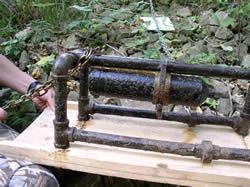
Surveys
Fisheries Management conducts surveys in the spring and summer to monitor the populations of adult and juvenile lake sturgeon in the Milwaukee area.
Spring Surveys
Spring electrofishing surveys are conducted in the Milwaukee River to monitor the return of adult lake sturgeon. Since the beginning of the program, 4 adult lake sturgeon have been captured during this survey. The smallest 3, ranging from 41.5-49.5 inches, were all stocked as yearlings or fingerlings as a part of the rehabilitation program. The largest one captured was a 51.5-inch male who was originally stocked into the Milwaukee River as an adult in 2005. Other adult lake sturgeon have been encountered but not captured. During the spring of 2020 there were reports of multiple large sturgeon in the Milwaukee River. A law enforcement officer was able to capture a picture of one swimming close to shore. It is anticipated that there will be more adult sturgeon utilizing the Milwaukee River each spring as a result of the rehabilitation efforts.
Summer Surveys
Summer gill netting surveys are conducted in the Milwaukee Harbor targeting juvenile lake sturgeon. Since this annual survey began in 2013, 75 juvenile lake sturgeon from the Lake Michigan rehabilitation project have been captured. They ranged from 1-6 years old and 12”-34” long. On average, a juvenile lake sturgeon stocked as part of the program grows 4.5” per year. After age 6, juvenile lake sturgeon commonly seek habitat outside of the harbor area as they mature. Many of these fish are not encountered again until they return to the river to spawn.


